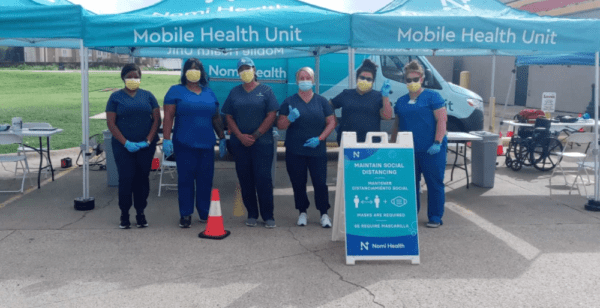|
Rock Health Telemedicine | Nomi Series A
December 15, 2021
|
|
|

|
|
Together with
|

|
|
|
“Old: Telemedicine as a business model. → New: Telemedicine as a tool.”
|
|
Rock Health’s 2021 Digital Health Consumer Adoption Survey
|
|

|
|
While we publish new telehealth trends virtually every week, Rock Health consistently adds more color to these stories with its deep dives into funding and consumer preferences. Its latest research in collaboration with the Stanford Center of Digital Health is no exception.
Rock Health’s annual Digital Health Consumer Adoption Survey of 8,000+ US adults sheds more light on self-reported digital health behaviors, exploring three core insights with plenty of charts included for the visual learners:
INSIGHT #1: Future care models will increasingly integrate asynchronous modalities. (Chart 1)
- 51% of this year’s respondents have used live video telemedicine, making it the most used modality over audio-only or text-based care.
- Rock Health predicts that asynchronous non-video modalities will gain popularity because they enhance clinician efficiency and enable proactive continuous care
INSIGHT #2: Telehealth satisfaction remains high but is trending downward. (Chart 2)
- 43% reported greater satisfaction with live video calls compared to in-person care, down from 53% in last year’s survey.
- The authors attribute the decline to the changing expectations around telemedicine as an alternative to care, rather than as a needed replacement.
INSIGHT #3: High telemedicine adoption skews towards the young and wealthy. (Chart 3)
- Telemedicine adoption is highest among high income patients aged 18-44, underscoring gaps related to broadband access, device ownership, and digital literacy.
- To address these gaps, Rock Health suggests that innovators understand the population they’re building for, and what factors drive that group’s adoption.
Telemedicine’s Path Forward
The survey suggests that telemedicine is beginning to focus on personalized treatments that address the nuanced needs of individuals, serving as a tool for care rather than a business model. Rock Health holds an optimistic view about the future of telemedicine, and with more scalable and equitable solutions hitting the market every day, that’s a safe stance to take.
|




|
|

|
|
Direct healthcare provider Nomi Health recently closed a $110M Series A round to help advance the company’s mission of addressing care gaps, a huge sum for a company that got its start in 2019.
- Nomi currently serves 30k daily patients across 10 states, providing care for those that prefer not to go through traditional payor / provider channels.
- The company deploys mobile care units to locations such as universities and local businesses to deliver on-site services including vaccinations, COVID testing, and preventative screenings.
- The direct healthcare model allows Nomi to bypass many of the operational inefficiencies faced by larger incumbents, lowering overall expenses for recently added offerings such as COVID-19 vaccines and monoclonal antibody treatment.
- The latest funding will help Nomi deliver more services to “care deserts” such as rural areas and prisons, while also expanding its direct healthcare acquisition business.
The Takeaway
Nomi’s Series A makes it the 63rd company to raise over $100M this year, although the size of the round is more in line with a Series C for a company further along in its life cycle.
The funding total not only reflects the boiling hot state of broader digital health investment, but also the size of the market that Nomi has set its sights on.
Expect some acquisition news from Nomi in the near term – $110M is a large war chest, and when they’re done picking up vans, they’ll likely add some competitors to their Christmas list.
|




|
|
Nuance’s Patient Engagement Must-Haves
Consumer demands are shifting, and they’re looking to get more out of their digital health technology. Nuance outlines the 5 must-haves for your patient engagement strategy here.
|
|
- Rise of Behavioral Telehealth: ASPE released data on Medicare FFS beneficiary telehealth visits in 2020, showing that total visits increased 63-fold from approximately 840k in 2019 to nearly 53M in 2020. The data also highlighted why digital behavioral health companies have been attracting so much investor attention: telehealth visits made up 38% of behavioral health visits in 2020 (vs 1% in 2019), the largest increase of any provider type and a trend that’s likely to persist beyond the pandemic.
- DispatchHealth’s Nationwide Imaging: Home care giant DispatchHealth just became one of the US’ largest mobile imaging providers with its acquisition of Dynamic Mobile Imaging. The acquisition allows DispatchHealth to add imaging to its suite of in-home services across much of the Midwest and Eastern US, and gives it a distinct advantage over remote care companies without imaging capabilities. Mobile imaging plays a key role in DispatchHealth’s strategy to create the “world’s largest in-home care system,” a goal that suggests more acquisitions could be on the way.
- Home Care Gap: New research from CarePort found a 10% sustained increase in referrals to home health agencies since the beginning of the pandemic, while referral acceptance rates have declined ~15%. The findings also show that discharge planners are electing to guide patients home over skilled nursing facilities due to pandemic worries and staffing shortages, resulting in hospitals sending more referrals to a larger network to ensure treatment for their patients while the care gap widens.
- Innovaccer Series E: Healthcare data company Innovaccer recently closed a $150M Series E round ($379M total funding), driving its valuation to $3.2B following the rapid adoption of its Innovaccer Health Cloud. Innovaccer has seen recent success due to the growing number of providers implementing value-based care models, which need solutions such as Innovaccer Health Cloud to turn their siloed data into a single actionable view of their patients.
- Voice-Based AI Coaching: A recent study published in Nature investigated whether AI coaching interventions increase physical activity (PA) among overweight physically inactive cancer survivors, randomizing 42 patients into equal groups for testing (voice-based AI coaching <MyCoach>, text message AI coaching <SmartText>, control). After four weeks, average daily steps increased in the MyCoach group by 3.6k, significantly higher than the SmartText and control groups, suggesting that voice-based AI coaching has promise for increasing PA in sedentary cancer survivors.
- Walgreens Primary Care: Walgreens CEO Roz Brewer recently spoke at the 2021 Forbes Health Summit to outline her company’s evolving healthcare strategy, revealing that it plans on having primary care clinics at nearly half of its 9k stores, with two physicians at each. Given the roughly 200k PCPs in the country, Walgreens would account for nearly 5% of the PCP workforce, and with CVS also planning to staff physicians in its upcoming primary care locations, it appears we could be heading toward a future where retail clinics account for a significant portion of the primary care landscape.
- Mammography Self-Scheduling Benefits: A new Mayo Clinic study highlighted their mammography screening self-scheduling platform’s impact on patient convenience and staff workloads. Fifteen percent of patients used the scheduling platform in its first year (14k/93k), with 75% of self-scheduling happening during non-business hours. The self-scheduled appointments were far more likely to require a single setup step than staff-scheduled visits (93.5% vs. 74.5%) and rarely required staff to “clean up” incorrect appointment settings, although they also had higher no-show rates (5.7% vs. 4.6%).
- Ophelia Opioid Recovery: Ophelia raised $50M in Series B funding to expand the reach of its medication-assisted treatments to more individuals with opioid use disorder (OUD). Ophelia’s telehealth platform connects patients to remote care teams (prescribing clinician, nurse, care coordinator), with a goal of reaching the 80% of Americans with OUD who are unable to access care due to infrastructure and technology barriers.
- Physician Gender Disparities: A new Health Affairs study found that female physicians in the U.S. make $2M less than their male colleagues during a 40-year career (n = 80k, $6.2M vs. $8.3M), indicating structural gender bias unrelated to time-off for raising children given that the researchers adjusted for hours worked, specialty, and practice type. Female physicians’ earning disparities were greatest for surgical specialists and nonsurgical specialists (-$2.5M & -$1.6M).
- Medicare Reprieve: American providers breathed a sigh of relief after Congress passed legislation that will soften upcoming 2022 Medicare cuts. Once president Biden signs it into law, the 2022 Medicare conversion factor rate for physicians will increase by 3%, the automatic 2% Medicare payments cuts will be suspended through June 30th (and then reduced to 1%), and the 15% reduction in clinical diagnostic lab tests will be eliminated for 2022.
- Cadence Funding: Remote patient monitoring company Cadence recently raised $100M in Series B financing, bringing its valuation to over $1B within months of its emergence from stealth. Cadence offers a clinically proven RPM platform for chronic condition management, improving patient outcomes through a combination of connected devices, support from nurses, and remote access to their care teams.
|
|
|
|
|